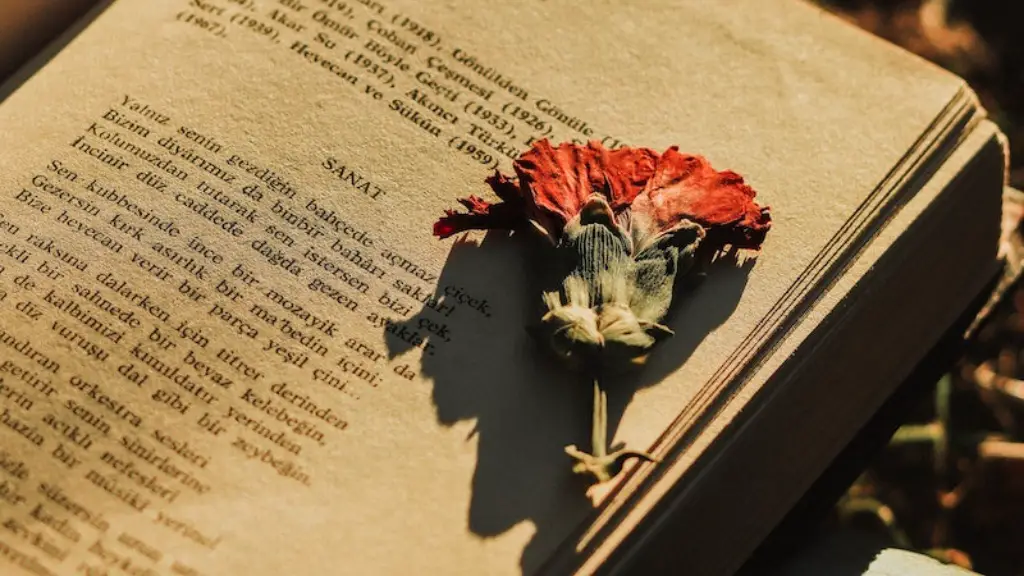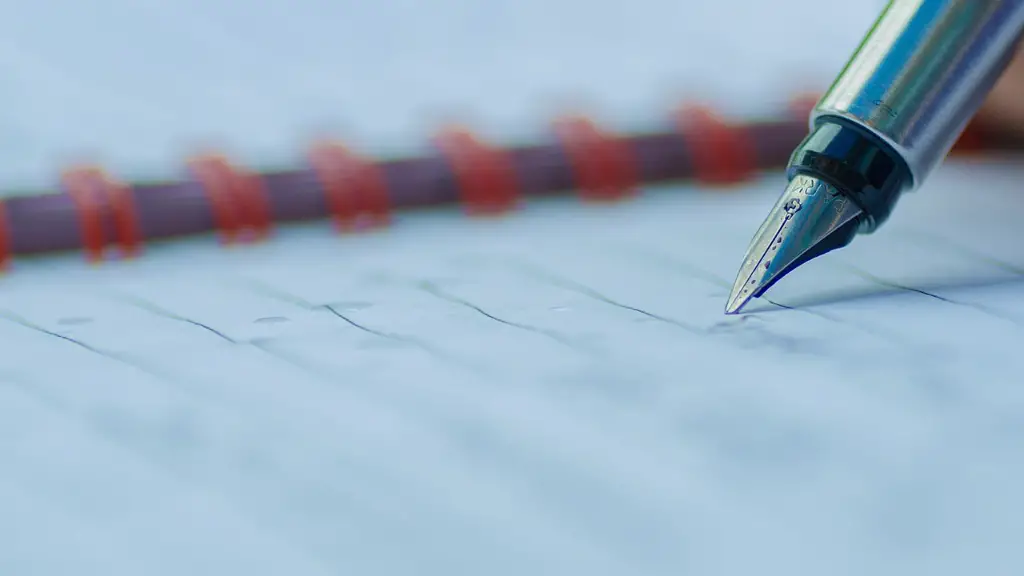What Is A Stressed Syllable In Poetry?
Poetry is a form of creative expression that has been used for centuries to relate emotion, feeling, ideas and stories in an extremely beautiful and powerful way. Poetry is made up of patterns of words, which create special sounds, themes and ideas that have a deep and lasting impression on us. One of the most essential elements of poetry is the stressed syllable, also known as a metrical unit. Being aware of why and how stressed syllables in poetry are important can help deepen the understanding of the words, deepen their meaning and make the poem far more enjoyable.
The stressed syllable is the emphasised syllable within a word found in poetry. It is the part of the word that stands out the most, for example in the word ‘power’ the stressed syllable is ‘pow’. How it stands out can also depend on the surrounding words and the context of the poem. If a poem is written in a specific rhythm, such as metre or rhyme, it is likely to feel more powerful and emotional. Knowing where the stressed syllables are within the poem is what helps to create said rhythm.
Stressed syllables are an essential element of poetry as they differ it from prose (non-metered writing) and its presence can result in a much more dramatic and emotional piece of writing. A stanza, or line of poetry, is often made up of a set number of stressed syllables referred to as feet. For example, the most common feet are the iamb and trochee, which consists of 2 syllables, with the opening syllable unstressed and the closing one stressed, like the word ‘begin’. Knowing where and when to put the stressing syllables helps to give the poem structure and balance, allowing for a well-crafted piece of writing that won’t soon be forgotten.
Experts suggest that there exists a colour and musicality to poetry. The colour is created by the way words themselves sound, and the musicality by the way they are put together in a line. Enunciating the stressed syllables can have an extremely impactful effect on the poem, and even more so when reading the poem aloud. It can help to add emphasis and longevity to memorable words, giving them more force and impact.
Because each culture has its own set of rules regarding which syllable gets stressed, the way a poem is read and written will vary based on where the poem is being read, who is reading it and how old it is. For example a poem from the Romanticism period may have different stressed syllables and cadence than a modern-day poem, however the basics of how to find and read the stressed syllable remain the same.
The best and easiest way to understand the stressed syllable is to read the poem and engage your ear. You can try to emphasis the syllables as you are reading, as it will help to create a flow, rhythm and meter. It is also often a good idea to try reading the poem out loud and even practice a few times. Reciting the poem in a variety of different ways will help to not only understand the poem more deeply but will also help to create more emotional connection with the piece.
How Can I Find the Stressed Syllables in Poetry?
Finding stressed syllables in poetry can be quite simple yet also lead to vast improvements in the knowledge of how to interpret web-poetry. One will first need to read the poem – out loud or quickly talk over the poem – and look for natural accenting words. Emphasising certain words or syllables can instantly tell you which ones are stressed. In addition to this, many dictionaries provide stress-markings on words which can instantly give away the stressed syllable in each word.
Going beyond this, poets can choose to create their own rules and meter. They can decide what the stress-pattern of the poem should be, including adding more stresses or removing some to create a more relaxed, subtle feel to the poem. This is called a caesura and is a technique used to create a more relaxed feel. Poets are also able to create their own slang by replacing formal words with slang and then manipulating the stress-pattern and meter to help re-inforce the words meaning.
Rhythm and meter works as a medium to bring together words and sentences in a language. The sound and structure of the words and how long each syllable is held has the power to bring the meaning of the words to life. When looking for the stressed syllables, start by naturally emphasizing the words in your own head. Then practice out loud or with a friend to make sure everything sounds right. Practice makes perfect and this is an extremely important element when it comes to understanding poetry.
What Are the Ways to Use Stressed Syllables in Poetry?
Stressed syllables can be used in a variety of ways in poetry to create emotion, rhythm and atmosphere. It can be used to demonstrate subtle nuances and abstract moments and also to deliver thoughts with great force. Most commonly stressed syllables are used to create rhythm, as metre and rhyme are perhaps the most powerful ways to make a poem more dramatic, horror-filled or seductive. Speaking in regards to iambs, the most common metrical foot in poetry, the pattern of unstressed-stressed syllables can easily create a tempo in the poem that can stir up feelings.
In addition to creating rhythm, the unstressed- stressed pattern can also be used to emphasise certain sentence within a poem. By creating a pattern of unstressed-stressed syllables, some of the words in a phrase will become more prominent and louder which will help to bring greater emphasis to them. This then can be used to add definition to the words and bring greater understanding as to why they are being used. In addition to this, the unusual use of stressed syllables can also create a subtle and unique choice of vocabulary, which might not be found in the traditional English language.
It is important to note that stressed syllables can be used to build the overall atmosphere of a poem. Within a stanza, poets often choose to manipulate the stressed-unstressed patterns to create tension and create an atmosphere. For example, if a certain stanza opens with an unstressed syllable followed by a stressed syllable followed by an unstressed syllable, a different atmosphere will be created than if the poem started with two unstressed syllables followed by a stressed syllable.
The manipulation of the stressed syllables in poetry can have a substantial effect on the poem, however it is their use that helps to give the poem a truly unique feel. When used correctly, stressed syllables can help to bring the poem to life and create a great atmosphere and emotion.
What Are the Benefits of Understanding Stressed Syllables in Poetry?
Understanding the use of stressed syllables in poetry can be one of the most rewarding aspects of reading and writing poetry. Not only does it help to give a greater depth to the poem, but understanding stressed syllables help to create the feeling of something that is truly crafted with love and thought. Being able to understand the patterns in a poem and how it has been constructed can result in a deeper understanding of how each part of the poem fits into a wider context, as well as help one to feel more connected and emotionally involved with the words and their meaning.
Understand how the stress pattern is used throughout the poem can be extremely useful to remember, because it can help to create an atmosphere that lingers with the reader and carries them through the poem. As mentioned previously, stressing a certain syllable in a word can emphasize a feeling and add a subtle undertone to the word. When used in the right settings, this can help to add great power and strength to the poem.
Stressed syllables can also help to give an extra pizazz to the poem. Taking time to consider the stressed syllables and pattern in a poem can bring with it a complexity and layer of emotion that can both deepen the impact of the poem and make it more interesting. Having words that are linked by theme and meter, rather than being isolated by themselves, can bring a grander and further depth to a poem.
What Approaches Should I Take When Writing Poetry?
When writing poetry, it is important to take an analytical approach to understanding and writing stressed syllables. Taking the time to slowly read and consider the poem is essential, as it will help to create a clearer understanding of how best to construct and deliver your poem, as well as how to emphasise the words and syllables.
When writing poetry, it is useful to consider experimenting with different meters and patterns. Look at words, sounds and syllables and consider how they can contribute to the poem. Think about how the stressed syllables can be placed together in a phrase or line to generate a more powerful effect and play with the poet’s choice of words.
As when reading, practice plays a key role in writing poetry. Spend some time attempting to write poems with a focus on the stressed syllables and then revisiting them. This will help to consider the poem more deeply as a whole, creating a more powerful and meaningful piece. Additionally, you can proofread and edit with a friend, as they can help to pick out any subtleties and nuances that you might have missed.
What Resources Are Available To Support My Understanding of Stressed Syllables?
When it comes to learning about stressed syllables and how to use them correctly in poetry, there are a variety of resources available which can be of assistance. Whilst taking a class or speaking with a professor or mentor is often the most effective way in learning, there are many online tools available to help people understand how to correctly use and construct stressed syllables in a poem.
YouTube is one of the best resources to brush up on understanding stressed syllables. There is an array of videos available, teaching and explaining the basics of the stressed syllable, right up to more complex engineering of meter and rhyme. Many of the videos are made using reciting existing poems and walking through how best to construct the poem and why certain syllables are emphasised. As well as this, many resources offer ways for people to see how their own poem’s stressed syllables might sound and the effect it will have on the poem.
In addition to video resources, poetry blogs are another great way to get advice. For example, many of the poetry blogs online have advice section, with guidance tips and tricks on not only understanding stressed syllables but also on how to use them in a poem. Most of the blogs feature advice from experienced poets, making them highly valuable resources as it comes with a personal touch and reflection.
Whilst understanding what a stressed syllable is and how to use them properly in poetry can take time, the reward is usually great. Being able to understand, read and write the poem better can have a great impact and often will bring a greater level of enjoyment and understanding of the poem. If you are looking to make the best out of your poetry, understanding how stressed syllables can help your poem can be a great way to start.





